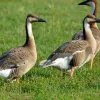
Ross's Goose (Anser rossii)
Species name
- Dutch name:
- Ross gans
- English name:
- Ross's Goose
- German name:
- Zwergschneegans
- French name:
- Oie de Ross
- Scientific name:
- Anser rossii
Scientific classification
- Order:
- Anseriformes
- Family:
- Anatidae
- Onderfamilie:
- Anserinae
- Genus:
- Anser
Description
- Description:
There are two color phases: White and the Rare Blue"Black" Phase. Ross' geese are the smallest of the three varieties of white geese that breed in North America.
The Ross' goose is a small white goose with black primary feathers. The bill is a deep reddish-pink with a paler nail and a variably bluish warty area over the base of the basal area. The legs and feet are rose-pink and the iris is dark brown. The sexes are dimorphic, with the female being 6 percent smaller than the male. The Ross' goose has a relatively short neck and lacks the black "grinning patch" that is typical of greater and lesser snow geese, for which it is often mistaken. Ross' geese may be distinguished from snow geese by their smaller size, more rapid wing beat and higher-pitched call.
Standard Measurements
- Body Length (cm):
- The male (drake) of the Ross's Goose measures approximately 53-66 centimeters. The female measures approximately 48-64 centimeters.
- Body Weight (grams):
- The male will weight about 1220-1635 gram. The female will weight about 1190-1510 gram.
The weight is notoriously variable and can only be used as indication!
- Note:
Ross's geese are generally hardy and easy to manage. They are usually gregarious and many species may be kept in flocks, however they tend to be territorial and aggressive in the breeding season and some may need to be maintained in separate pens. It is often possible to keep small ducks with pairs of geese, unless the individual goose pair is particularly pugnacious. They should always be provided with adequate water for swimming.
For a single pair of Ross's geese a total pen area of 200m², with at least 20% of this area water is suggested, although more water should be provided if possible in a larger pen.
Ross's geese are grazers and should have access to good short grass for grazing. Breeding success may be decreased if these species are allowed to become too fat and this can be problematic particularly for the species which normally breed in the high Arctic.
Goslings may be parent hatched and reared, although being mainly terrestrial they are more vulnerable to predation than are cygnets. Whether parent or hand-reared, goslings should be provided with unlimited grazing and other green food such as chopped lettuce, as well as starter crumbs.
Ross's geese are hardy and easy to manage. They should be provided with a large area of grazing and clear, pure water. They usually mix well with other waterfowl, and tend to remain if kept full-winged. In addition to grass, they may be fed with Lundi Regular floating Pellets, and avoid overfeeding.
These geese are fairly easy to breed. They appreciate some natural cover for breeding, and they usually lay from May to June.
- Breeding:
- The female Ross's Goose usually lays from 4-5 pink to white eggs and incubates them for 21-24 days.
- Artificial incubating:
The ideal relative humidity for incubating most waterfowl eggs is 55% (ground nesters) and 40% (cavity nesters). The temperature is usually 37.4°C. Set ventilation as recommended by the incubator manufacturer. Eggs must be turned, either automatically or by hand, a minimum of 4 times a day. As the duckling develops there is a loss of water from the egg and the air sac gets bigger. In normal development of an egg with a 21-24 days incubation, the air sac occupies about a third of it three days earlier. Cleanliness is vital and ideally eggs should be moved to a separate hatcher at this point, where the humidity should be increased to 65% and even higher once they have pipped internally.
- Bird banding:
- Recommended closed leg band ring size for the Ross's Goose is 14 mm.The leg band ring can only be applied on a young goose at around 12-14 days old.
- It doesn't matter what leg that you band, but it's good to have a consistent system. Suggested: Left leg = Female, Right leg = Male
- Maintenance food:
-





Lundi Regular with a protein content of 20%, valuable Spirulina and high-quality by-products is optimally balanced in its composition maintenance food for water ornamental fowl of all kinds. Especially green teal and Whistling ducks that are not dependent on a very high protein content, are well supplied.
Lundi Regular contains all the minerals and vitamins in full form that are important for the animals. Therefore also suitable as breeding food.
- Regulation:
- Europese soort
- Regulation:
Het is niet verboden om deze vogels te houden die van nature in Nederland voorkomen, op voorwaarde dat deze vogels in gevangenschap zijn geboren; nakweek dus. Deze vogels zijn voorzien van een gesloten pootring. Het is wel verboden om deze vogels te houden die in het wild gevangen zijn. Alleen bepaalde instanties, zoals vogelasiels en vogelhospitalen, zijn bevoegd om jonge en gewonde wilde vogels te houden. Deze bescherming van vogels wordt vormgegeven door schadelijke handelingen te verbieden zoals:het doden, verwonden, vangen, bemachtigen en met het oog daarop opsporen van vogels (art. 9 Flora- en faunawet); het opzettelijk verontrusten van vogels (art. 10 Flora- en faunawet);het beschadigen, vernielen, uithalen, wegnemen en verstoren van nesten, holen of andere voortplantings- of vaste rust- of verblijfplaatsen van vogels (art. 11 Flora- en faunawet);en het zoeken, rapen, uit het nest nemen, beschadigen of vernielen van eieren van vogels (art. 12 Flora- en faunawet).


